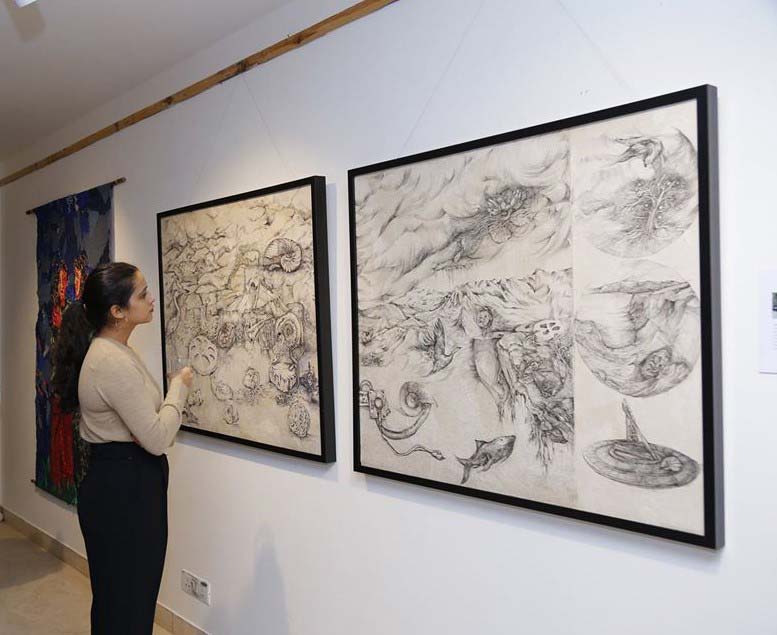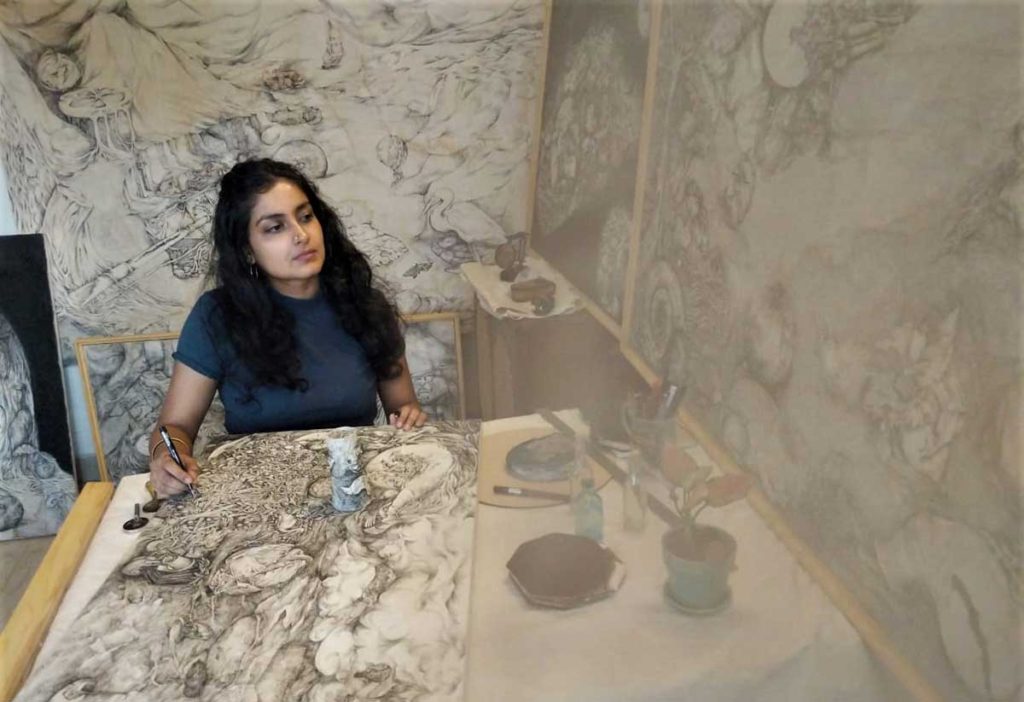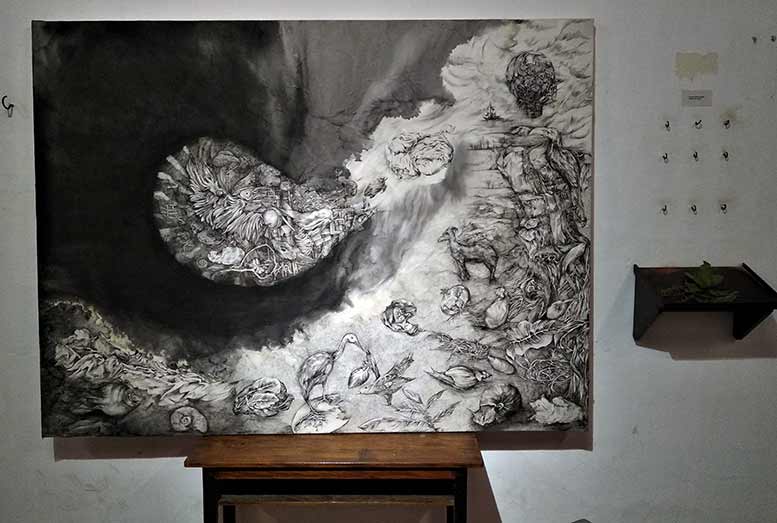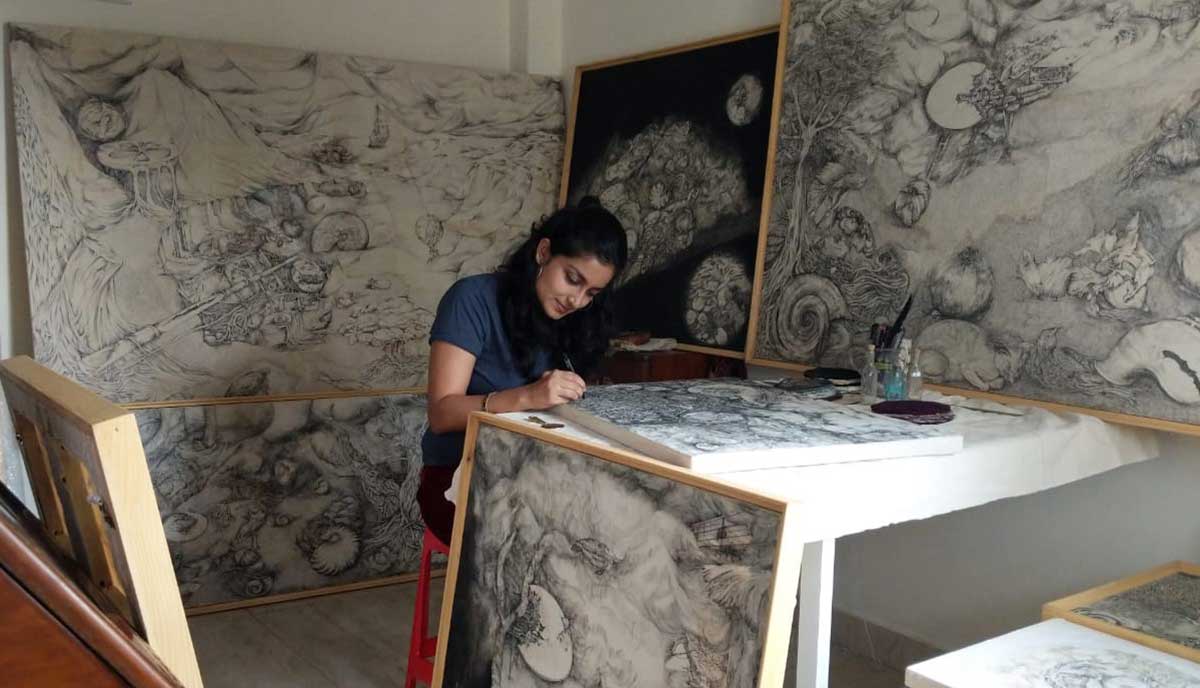Contemporary artist Meghna Patpatia talks about finding solace and direction in her work, in an interview with the Asian Curator.
“I believe that the most raw and relatable visual expression that a human can create is a mark made by the hand.”
Contemporary artist Meghna Patpatia
Featured image: In studio, Bombay. Contemporary artist Meghna Patpatia. Image courtesy – Praseed M Varma.

Contemporary artist Meghna Patpatia. Portrait courtesy – Praseed M Varma.
Please tell us a little about yourself, what brought you to the world of art and how did you start?
As a child I took to drawing more than anything else. I don’t remember not using a pencil or crayon at any point to escape. I would scribble on a sheet of paper or even bare walls. My parents knew of my inclination towards art as a toddler. And they encouraged me to express myself more through painting.
Growing up we shifted homes and cities constantly, which made an uncertainness prevalent in my immediate surroundings. My source of stability and consistency was the presence of art material that I would immerse myself into. No matter where I was, whether in a train or a flight, if I was sad or happy, I’d be doodling onto the desk or in my textbook. I always found comfort in my art pursuits. I knew that art would be an integral part of my life but wasn’t sure how to pursue it.
The idea of academia and the formal ‘studying’ of art concept, is something that I never took well to. I always associated contemporary art to be a more instinctive process and wasn’t sure if by making it a study I would lose interest in it. But I was proven wrong! Thankfully my parents had the foresight and enrolled me into Sir. J. J School of art. After being formally trained in painting as my major, I graduated with a B.F.A. This lead to a very solid beginning of my journey as a visual artist.
What is the primary role of a contemporary artist? How do you describe yourself in the context of challenging people’s perspectives via your work and art?
I believe that the most raw and relatable visual expression that a human can create is a mark made by the hand. To be deeply moved by art, one has to sense its purpose or sometimes the lack of it. Hence the role of an artist is to create a moving sensation that can instil emotions in the viewer, that are primal. Often the intent of the artist maybe to only reflect an observation of his or her immediate surroundings. But when viewed by an audience, their response to the artwork will vary depending on their own experiences.
To engage the viewer through the artists repertoire may make them think or escape or confront a reality that otherwise maybe shrouded to them. It could be interpreted as being therapeutic and hypnotic in some cases. An instinct exists in every one to respond immediately to a colour or pattern that creates a stir in the imagination. For me a form that may seem mundane or regular to most people, becomes a thing to marvel at. And I want to acknowledge it by revering the same form through my art.
Through this act I want to record the forms that I feel deserve a space in history, to remind and remember. I would like it to be a memory encapsulated into my magnifying glasses or painting surfaces. My medium of choice reflects this thought process on a viewer. And they may or may not be able to grasp the intention. But I sure hope they are able to understand the painstaking nuances of nature through my details.
How do you deal with the conceptual difficulty and uncertainty of creating work?
For the longest time I struggled with understanding the flow of ideas that would instinctively provoke me to first explore in the form of a sketch and then evolve through a bit of research about the same. Going from one point of reference to another, I took some time to grapple with these changes
I realised that they are all interconnected. As and when I reach a place where I am uncertain about how the works will take shape I remember to take a step back and observe how I had worked on a previous concept and how it is taking me to the next plane of thought. That connection of thought and common thread that connects my concepts to one another creates a base, thus helping me to continue creating newer works.
During these Covid times especially one realises even more how uncertain our times can be. Since most of my childhood was spent shifting to new places, I’m hyper aware that I need to create art to find peace in the knowledge that I find that I feel a small sense of control and familiarity while making art. The familiarity sometimes breeds an indolence, which I then try to change without convoluting the original thought. The element of surprise though is always unprecedented and adds layers of dimensions to the terrain created.

Exhibition view. Heirloom of the senses, Delhi, India. Contemporary artist Meghna Patpatia. October – November 2019. Image courtesy – Champatree gallery
What would you call your style? Lets talk about the evolution of your practice over the years. Tell us about your commitment to your current medium.
My inclination has always been to draw, more than paint. I took to the portrayal of linear patterns and navigated intricate landscapes to represent the outer world. As a young child I drew with pencil and loved portraying creatures in a linear form. This has evolved into a far more intricate study where I now work with ink and pens of varying thicknesses in my artwork currently. I wouldn’t like to confine my style into any specific category, although there are elements of morphism, surrealism and dreamscapes.
Over the years it became more apparent to me that the surface layer of the work is a prominent part of my drawings. Previously my surfaces to create drawings on were plain paper, cardboard or canvas to paint on. I studied art restoration and worked in the field for a few wonderful years. While working in the field of restoration I came across various handmade papers of different densities. Which we would use to line old manuscripts and paper works using adhesives. I found paper as a medium even more intriguing and began to experiment with it, the base for ink and water to traverse freely on its very raw pulpy textures. Through experimentation and accidents the conscious flow of my drawings where nature and man-made elements coexist, found a surface that they could flow and find a suitable terrain to settle into.

Contemporary artist Meghna Patpatia. In studio, Bombay.
What inspires you? Lets talk about your frameworks, references and process.
I was intrigued by natural forms and creatures that surround us. So, I began my portrayal of these forms in dreamscape like surroundings back in college. And I started drawing by exploring forms affected by the phenomenon of transverse orientation, a phenomenon where all beings are drawn to light. The natural orientation of a moth for example is to be drawn to a flame which devours it. In the same way that this subconscious orientation affects all creatures, we as a race are hurtling towards so called progress and in the process burning all that is essential to our survival. This parallel inspired a series of painted drawings reflecting our coexistence and the precarious balance in which we edge towards an epoch of nothingness.
The changing landscapes and adaptation of species to these ever-changing scapes eludes me. Sentient beings that we see around us everyday and far out in different terrains witness changes being made by us to their surroundings. They witness these changes and adapt or flee. The eventual extinction and lack of resources are subjecting their survival and our own to a very grim future. The stark contradictions that exist in their simplicity and our complex manipulations are seen in the medium of detailed drawings with black ink on wide woven textile and fragile translucent handmade paper that is layered and pasted onto the cloth to create patterns that are natural and embedded in the surface layer of my drawings. I fell in love with this medium during the lining of manuscripts in the process of restoration.
Contemporary artist Meghna Patpatia on her choice of medium in art.
The medium has veined textures with the delicate translucence of the paper creating a nerve like pattern throughout the surface. The natural formations through ink and water trigger a terrain sensation upon which I draw morphs, forms, elements that coexist. The creating of these drawings using traditional art historical technique references that engage the viewer in a visual sensation based understanding of how the forms witness changes with different emotions based on their adaptation. The stark ink on paper, cloth is like a record keeper of the contrast existing. During residencies that I have been a part of, I absorb the creatures endemic to that terrain and render them into spaces that may seem unlikely to be permanent as they witness the environment shifting.
From the phenomenon my work evolved into following natural forms adapting to unexpected terrains in a series titled Where to now my beloved that is expanding to include different narratives that I have been exploring for example the Nautilus, one of the oldest living fossils that still exists in the realms of the deep sea. It has witnessed epochs since the Mesozaic era, its journey as a living fossil is one that I relate to as a creature that has adapted and witnessed so much. Which is why it is ever present in almost every drawing of mine, almost like a representation of mother earth.
The sea turtles have a peculiar way of finding their way home, they follow the moon light, now that man has planted large lights on the beach these earnest turtles find the direction home to be confusing, so we see them arriving on our sea shores. The Persian myth about Simorq a mythical bird that is a connection between earth and sky. These are stories for me that give rise to many visuals that narrate and engage me in a way that I want to pay tribute to all of these creatures by following their journey into dreamscapes that may transport the viewer into that realm of uncertainty and wonder.
The explorations using the forms drawn on magnifying glasses was an experiment that I explored to understand how a magnifying glass is an examination tool used by mankind to learn how to manipulate natural resources. The extinction of natural forms and terrains, intrigued me and hence my drawings needed to be captured within a memory that I felt best resided in a magnifying glass. The conscious observe the artificial and the growth patterns that emerge from the two synergising.

Experiments with glass & details at Kalakriti art residency, Hyderabad, India. Contemporary artist Meghna Patpatia. May, 2019.
Lets talk about your career, or if you prefer artistic journey. What were your biggest learning and hiccups along the way?
My whole life has been about observations that translate into my art practice. Every incident, literature I come across, experiences personal and professional all feed into my art. I always felt that I wanted to help people though contemporary art. Finding tranquility while drawing is something I wanted to be able to share with others who needed it. So I yearned to help through any ability that I could share. By practicing art therapy or being of assistance to museums and private collectors. And through art restoration which is skill based and a very sensitive engagement for a person with an antique artwork. My artistic journey has been very diverse. And this has spilt onto my concepts as they keep evolving and reflecting my experiences in the forms of creatures seen in my artworks.
I went through a major hiccup in 2015. I learnt that I needed to focus more on my own art practice after I went through terrible health problems due to overworking and exhaustion. Post my graduation in painting I pursued Museology and Conservation studies, to be of help to beautiful old artworks, institutions that house them. To study them and to be able to restore them was an honour for me.
Also I needed to explore more opportunities to financially support myself as a young graduate. I sought inspiration for my own art practice while restoring art during the day and learning about their history and create my own artwork in the night. It was a surreal and demanding time and eventually lead to serious health problems which forced me to put a stop to everything. I had to be on bed rest for months on end. That was a turning point for me. I turned to my art practice fully and found solace in my drawings and started reading a lot. This gave rise to many concepts and a deeper understanding of my mind, I started being more instinctive and began exploring deeper theories and concepts related to the Anthropocene and how frugal our existence is.
Living with my parents, it wasn’t easy space wise for me to develop my concepts and physical artwork. And I needed a space to explore my art. So I found a job as an assistant manager at an art residency called What About Art in Bombay, where they provide art studios to artists from all over the world. I worked there on a part time basis and started using the studios that were unoccupied to create my own artwork in my free time. Eve Lemesle the director of What About Art residency, agency was kind enough to understand my need to create art. I worked there availing the free studios. It became the first space that I could finally develop my own concepts freely and execute them with no constraints.
This was a huge learning for me by 2017, as I realised then that this was where I could finally lay the foundation for my future art practice. I created a body of work over a course of 2 years and finally could apply for art residencies, participate in my first exhibition and take my practice forward constructively. I’m very grateful to all the contemporary artists I met at the residencies and different spaces that I visited as I could only really explore and imbibe so much into my art from the different energies I was exposed to.
Think of the biggest professional risk you’ve taken. What helped you take that risk? What is the best piece of advice you’ve received? Why was it helpful?
The biggest professional risk I’ve taken would be to choose to pursue my art practice as my source of livelihood. Tempting, potential art related opportunities like a career in art restoration, come by. They bring with them a promise of leading a cushy life with stable income and professional growth. Choosing an uncertain career path as a visual artist is definitely the biggest risk I have taken. What helped me take the risk was the major break in career that I had to take due to health constraints. Without which I probably would have taken a longer time to follow my art practice. And I would have wasted many precious years.
So in a way that incident made me realise what I was meant to do a lot sooner. I was shy and reserved about exhibiting my art and showing the artworks I made to the public initially. At the time I received an interesting piece of advice from a senior contemporary artist who told me that ‘you’ll meet a lot of artists, curators, collectors, gallerists who may not perceive your art as personally as you imagine them to. They come with a different set of evaluation tools, expectations, perceptions you must learn to not be very emotional when interacting with them.
They can have different views and ideas that may take you by surprise. Learn to welcome it and be open to new perceptions. I am unable to disconnect from the making of my own art coming from an emotional place. It is a part of my very being. This piece of advice came from a senior contemporary artist early in my career. It helped me overcome my anxiety about showing, sharing, exhibiting my work to unknown people and the public.

Image courtesy – Kashi art residency, Kochi, India. Contemporary artist Meghna Patpatia. July, 2019.
Tell us about your studio, what kind of place is it? Could you describe your usual work day in the studio?
My studio is cozy, well lit and ventilated. Working on my paintings in natural light is essential to my practice. I prefer natural light to artificial light any day and even go outdoors to paint sometimes. My mornings are a bit slow as I need to just be by myself and have a set of routine things to complete post which I’m ready to start working. I work mostly during day time. That is normally around 12.30pm through the whole day till the the sun goes down. Sometimes I work late into the night if I feel a need for the absolute silence and calmness that the night time brings.
Being so detailed, my drawings are physically demanding. So I often need to rest between work hours. I have a snooze space also where I can escape into to hibernate and read. Then I return to my art with a renewed energy. I have many windows with plants, trees and birds outside. I’m very fortunate to have found this space in a city like Bombay and hopefully it stays with me for a long time. I have bird feeders hanging outside the window too so I can spend time observing the different birds visiting and sketching them.
I take a walk around the city to spaces that are crowded. Sometimes I go to the sea side, and collect little things that may affect my work in some way. Bring them back to my studio may give rise to a concept or idea that I can take forward in my painting. It could be anything from a discarded wire to a broken twig or eggshell that can give rise to a new drawing. Walks around the city and travelling are an inherent part of my practice. I need them regularly to engage with. Post which I retire into my studio and attempt to assemble my thoughts and forms.
How does your audience interact and react to the work you put out into the world?
People ask me about my process and enquire about the medium. It is a wholesome feeling to watch people engage with my artworks in different capacities. It is especially marvelous to read a child’s behaviour when in front of your artwork. They look at it with so much innocence and curiosity. Last year, at my exhibition, a child walked and linked all the forms to one another creating a narrative of his own. This was a very gratifying experience for me. I felt elated that I was able to stir his imagination through my painting. He even named the painting ‘ sea room’ which I found so endearing.
I used to feel that my paintings are too personal at times to expose them to certain harsh perceptions and views that unknown people may have, over time and with some experience I now feel more accepting of different viewpoints and have learnt that it is with some amount of exposure and interaction that I get to see and learn diverse reactions which aid me to grow in every way.
A memorable incident was from an exhibition titled ‘Here among the disappearing’2019. An elderly lady from Switzerland, called Pam who was on a visit to Bombay was marveling at my work. She said that she was so happy to have been able to see my paintings on her trip. It meant so much to her because she believed in worshiping light. And all my works are about following the light consciously and unconsciously. I felt elated that I was able to instill such a personal feeling in her through my art. She went on to collect one of my works too which made me very happy.

In studio, Bombay. Contemporary artist Meghna Patpatia.
What are you working on now? What’s coming next season?
I’m currently working on changing landscapes and ecological narratives that I have been exploring over the years. With the lockdown came a time to internalise and explore further thoughts related to our everyday mundane activities. I am constantly intrigued by concepts related to time, space and causality. This is the transcendental idealism phenomena where they are all connected to one another.
The environmental changes in our immediate surrounding are starkly apparent with the lockdown. It is difficult not to incorporate these obvious phenomenas like the stars looking brighter in the sky with the drop in air pollution in the city. The energy among the birds and animals around us are also infectious as we can see them out and about fearlessly. This has given rise to a series of drawings titled ‘Adapto-cology’. The trees are somehow greener and the skies are beautiful. I’m thankful for this time to reflect and absorb all of these occurrences into my paintings. Hopefully they translate visually with future upcoming residencies and exhibitions.
I have been awarded a 2month long residency with Space 118 called the Space contemporaries residency which is to happen in September, 2020. It may get postponed to a later date because everything is now uncertain with the lockdown. I participated in a group show titled ‘Collab’ curated by the talented Jesal Thacker. This was scheduled to be a physical exhibition at Sakshi art gallery in Bombay. But because of the lockdown, it was translated into an online exhibition in May-June, 2020.
‘Collab’ is to materialise as a physical group exhibition at Sakshi art gallery. Hopefully by the end of this year when things are back to normal. The theme of the show has its roots in the oncoming Anthropocene. Artists are invited to showcase their artworks in relation to the ecological changes and occurrences that are all around us. I’m looking forward to that happening soon. With the current scenario affecting everything, future exhibitions which are in the pipeline for 2021 are still being discussed.
Are you more of a studio artist or naturally collaborative by nature? How do you feel about commissions?
My artworks and practice are very personal to me which means that I need a more intimate, private space to create. That makes me more of a studio artist in a certain capacity. Collaborations are welcome though depending on the nature of the work, cause and other artists involved. Commissions are definitely fun to do and I welcome them if they are in line with my sensibilities and expression. I find that commission’s sometimes can challenge you to think and innovate in a different way.
For enquiries contact: meghna [dot] patpatia [at] gmail [dot] com
Before you go – you might like to browse the Asian Curator curatorial archives . Contemporary art curators and international gallerists define their curatorial policies and share stories and insights about the inner runnings of the contemporary art world.












Fantastic work, Meghna. Extremely interesting to note your current theme adapto-cology. It is a fact that the lock down has given nature a new look, less pollution, greener land and brighter sky. Wonderful that you are able to draw inspiration from this ecological transition.